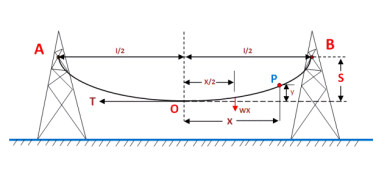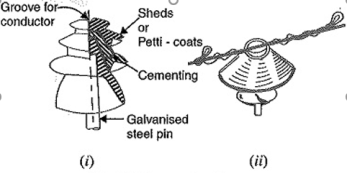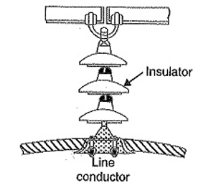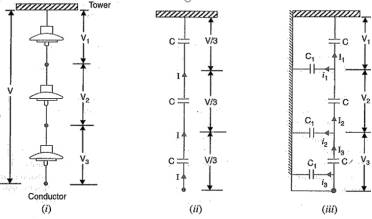Unit - 3
Mechanical Design of Overhead lines and Insulators
Q1) Explain the main components of overhead lines?
A1)
An overhead line may be used to transmit or distribute electric power. The successful operation of an overhead line depends to a great extent upon the mechanical design of the line. In general, the main components of an overhead line are:
(i) Conductors which carry electric power from the sending end station to the receiving end station.
(ii) Supports which may be poles or towers and keep the conductors at a suitable level above the ground.
(iii) Insulators which are attached to supports and insulate the conductors from the ground.
(iv) Cross arms which provide support to the insulators.
(v) Miscellaneous items such as phase plates, danger plates, lightning arrestors, anti-climbing wires etc.
Q2) Explain the various types of line supports?
A2)
The different line supports used by transmission lines include,
(a) Wooden Poles
(b) Reinforced concrete poles
(c) Steel poles
(d) Latticed steel towers.
Q3) Explain conductor spacing?
A3)
The spacing of conductors is determined by considerations, which are partly electrical and partly mechanical.
Usually conductors will swing synchronously (in phase) with the wind, but with long spans and small size of conductors, there is always possibility of the conductors swinging non- synchronously, and the size of the conductor and the maximum sag at the centre of the span are factors, which should be considered in determining the phase distance apart at which they should strung.
As a rule of thumb, minimum horizontal spacing between conductors should not be less than 1% of the span length in order to minimize the risk of phases coming into contact with each other during swing.
Q4) Explain sag calculation at equal length?
A4)
Sag calculation when supports are at equal levels:

Figure. Equal sag
Let
A conductor is in the two equal level supports A and B.
O is the lowest point of the conductor.
l= length of the span.
w= weight per unit of length conductor.
T= Tension in the conductor.
A point has been considered on the conductor in the point P which is X length away from the point O & y length high from the bottom point of the conductor. It may be assumed that the curvature length ‘OP’ = x, and the following two forces will be acted on the portion ‘OP’ of the conductor.
- Weight of ‘OP’ portion conductor is WX which is acted at a distance x/2 from the point O.
- T tension is acted at point O.
The above two forces is equating movement about point O, we get
Ty = Wx X x/2
Y = wx 2 / 2T -----------------------------------------(i)
The value of y is the sag of conductor at point P.
As, at the support point A, x = l/2 and y = S,
Therefore, put the value of x and y in the equation (i), we get
Sag(s) = w(1/2) 2 / 2T = w l 2/ 8T
Q5) Explain the effect of ice and wind loading?
A5)
The weight of ice acts in the same direction as the weight of conductor ( i.e vertically down wards ). The force due to the wind is assumed to act horizontally.

Figure. Effect of wind and ice loading
Lets,
w= weight of conductor per unit length
= conductor material density x volume per unit length
Wi = weight of conductor per unit length
= density of ice x volume of ice per unit length
= density of ice x π/4 [ (d + 2t) 2 – d 2] x 1
= density of ice x π/4 [ (d 2 + 2.d.2t + 4t 2 – d 2]
= density of ice x π/4(4 dt + 4t 2 )
= density of ice x πt(d + t )
W w = wind force per unit length
= wind force per unit area x projected area per unit length
= wind pressure x [(d +2t) x 1]
Therefore, the total force on conductor is the vector sum of the above two forces which is shown in fig.
Wt = √ (w+wt) 2 +(ww) 2
And tan  = w w / w + wi
= w w / w + wi
So, when the conductor has wind and ice loading
i) the sag of the conductor will be:-
S = w t l 2 / 2T
This sag represents the slant sag in a direction making an angle θ to the vertical. We can easily calculate the value of slant slag by using the above formula.
ii) The vertical sag = S cos ϴ
Q6) Explain pin type insulator ?
A6)
The part section of a pin type insulator is shown in Fig.(i). The pin type insulator is secured to the cross-arm on the pole. There is a groove on the upper end of the insulator for housing the conductor. The conductor passes through this groove and is bound by the annealed wire of the same material as the conductor.

Figure. Pin type Insulator
Pin type insulators are used for transmission and distribution of electric power at voltages upto 33 kV. Beyond operating voltage of 33 kV, the pin type insulators become too bulky and hence uneconomical.
Q7) Explain suspension type insulator?
A7)
The cost of pin type insulator increases rapidly as the working voltage is increased. For high voltages (>33 kV), it is a usual practice to use suspension type insulators shown in Figure. They consist of several porcelain discs connected in series by metal links in the form of a string. The conductor is suspended at the bottom end of this string while the other end of the string is secured to the cross arm of the tower. Each unit or disc is designed for low voltage, say 11 kV. The number of discs in series would obviously depend upon the working voltage. For instance, if the working voltage is 66 kV, then six discs in series will be provided on the string.

Figure. Suspension Type Insulator
Q8) Explain the Potential distribution over suspension insulators?
A8)
A string of suspension insulator consists of number of porcelain discs connected in series through metallic links. Fig. (i) shows 3-disc string of suspension insulator. The porcelain portion of each disc is in between two metal links. Therefore, each disc forms a capacitor C as shown in Fig.(ii). This is known as mutual capacitance or self-capacitance.
If there were mutual capacitance alone, then charging current would have been the same through all the discs and consequently voltage across each unit would have been the same i.e., V/3 as shown in Fig.(ii).
However, in actual practice, capacitance also exists between metal fitting of each disc and tower or earth. This is known as shunt capacitance C1. Due to shunt capacitance, charging current is not the same through all the discs of the string [fig. (iii)].
Therefore, voltage across each disc will be different. Obviously, the disc nearest to the line conductor will have the maximum voltage. Thus, referring to Fig. (iii), V3 will be much more than V2 or V1.

Figure . Potential distribution
Q9) Explain string effeciency ?
A9)
String efficiency
The ratio of voltage across the whole string to the product of number of discs and the voltage across the disc nearest to the conductor is known as string efficiency i.e.,
String efficiency = Voltage across the string / n x Voltage across disc nearest to conductor
Q10) Explain the methods to improve string effeciency?
A10)
The various methods for this purpose are:
1.By using longer cross-arms. The value of String Efficiency of Insulator depends upon the value of K that is ratio of shunt capacitance to mutual capacitance. In order to reduce shunt capacitance, the distance of conductor from tower must be increased that is longer cross-arms should be used.
2.By grading the insulators. In this method, insulators of different dimensions are so chosen that each has a different capacitance. The insulators are capacitance graded that is they are assembled in the string in such a way that the top unit has the minimum capacitance, increasing progressively as the bottom unit that is nearest to conductor is reached. Since voltage is inversely proportional to capacitance, this method tends to equalize the potential distribution across the units in the string.
3.By using a guard ring. The potential across each unit in a string can be equalized by using a guard ring which is metal ring electrically connected to the conductor and surrounding the bottom insulator. The guard ring introduces capacitance between metal fittings and the line conductor.. The guard ring is contoured in such a way that shunt capacitance currents i1,i2 etc. are equal to metal fitting line capacitance currents i′1,i′2 etc. The result is that same charging current I flows through each unit of string. Consequently, there will be uniform potential distribution across the units.